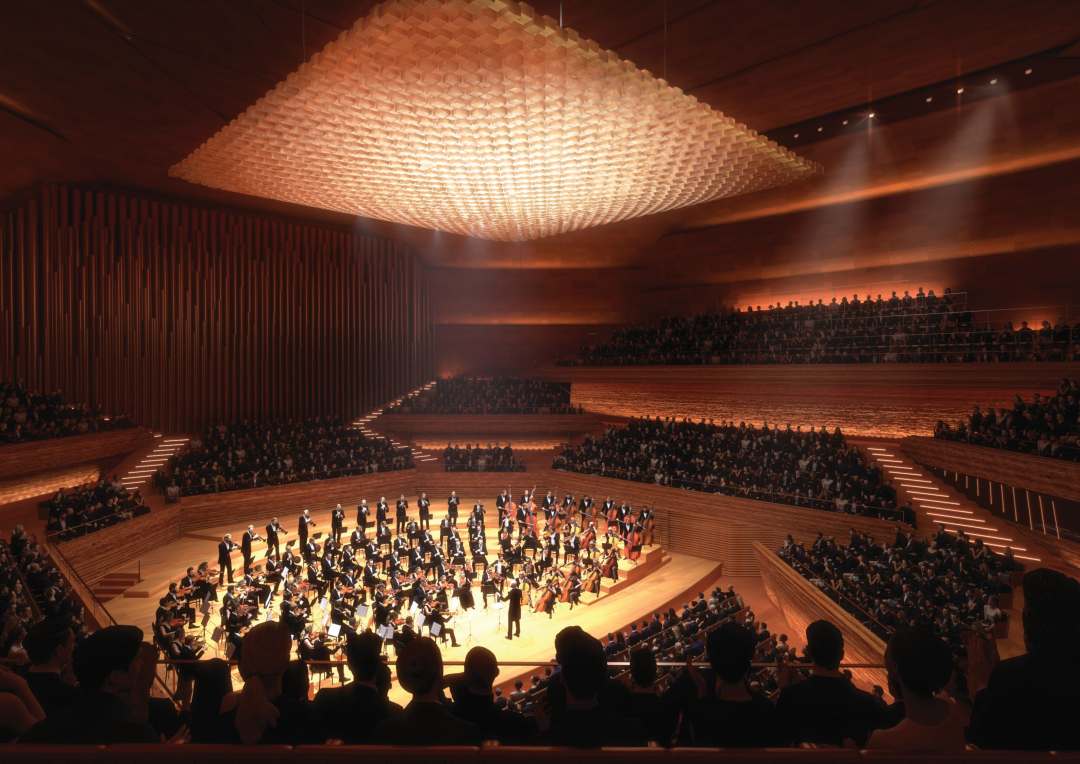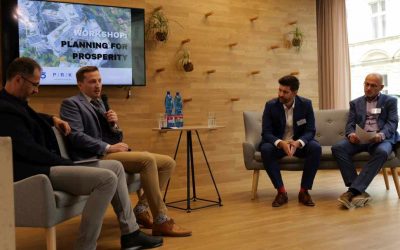One of the most influential Czech architects, and owner of the A8000 architectural studio, Martin Krupauer has extensive professional experience at home and abroad. This includes work with the Solnice cultural center and the creative epicenter Bazilika in his hometown of České Budějovice. Prague entrusted him with the leading the creation of a brief for the Vltavská filharmonie. The competition was won by the Danish studio Bjarke Ingels Group.
It’s clearly a prestigious thing to build a new concert hall, but CZK 9.4 billion is quite a lot of public money. How do you explain the wide acceptance of the project, especially since classical isn’t exactly for everyone.
Perhaps the most important thing to say is that it’s not just a concert building for 1,800 people who want to listen to challenging classical music. From the very beginning we thought of it as a national music center. It’s not supposed to be a building that gets dressed up only in the evening concerts but lies empty and dark during the day.
How does the building achieve this?
The most complicated and interesting part of the project was figuring out the overall program for the building. Because the goal is to ensure it’s used 24×7. That’s the approach taken by most of the modern concert halls we visited and studied. Hamburg’s Elbphilharmonie has classrooms and a variety of studios that are always busy. Paris’s new philharmonic is a huge musical hub with a range of classrooms, studios and presentation rooms. It’s used by everyone from amateurs to semi-professional musicians to young musicians preparing for a professional career.
The Vltavska philharmonic will have three auditoriums: the classic main hall, a chamber music hall and a third one we call the ‘black box’. This is a multifunctional hall that has an offering designed to appeal to people who would otherwise never set foot in a standard classic music concert hall.
But there’s also another interesting portion of the building: the creative hub, centered around the music section of the Prague City Library. It includes a dozen rooms of different sizes, with recording studios, a study and classrooms. The goal is for the building to be used from morning until night by people from around the country. We see it as a piece of national infrastructure that should be used for as many purposes as possible. I think we can all agree that we need culture in our lives. The philharmonic should be a vehicle that offers as much of it as possible of the highest quality.
 What stood out about the winning bid? Did it surprise the jury in any way?
What stood out about the winning bid? Did it surprise the jury in any way?
In putting together the competition’s conditions, we were thinking of the building rather horizontally and envisioned lots of people streaming through the building, even if they weren’t going to a concert. We also wanted to bring people up onto the roof somehow. But the winners took that idea and made it the guiding principle of their whole design. They took the idea of a city square and turned it into architecture by stretching it up to the roof. This matched our goal of creating a sort of connection between the building, the transportation hub and the river. We didn’t just want people looking at the building, we wanted them to go walking there. We specified that there should be a public lobby, or some type of passage that would draw them through the building. But they surprised us by pulling people upwards.
Another interesting aspect that featured in a few of the bids was that the geometric design of the main concert hall very carefully mirrored the outer geometry of the building. That’s not very common. Usually, the building looks much different from outside than it does inside, so that’s an interesting detail.
In a project of this size and complexity, the brief itself is of crucial importance.
If you want a good result, you have to have a good brief. You can’t solve anything once a building is under construction. At that point you just lose time and money, so it’s really all about the brief. And in our opinion, the winning team simply understood best what we wanted: a center for music, multiple layers, a connection both with the river and with public transport, and as much openness as possible.
Is that why the winning bid was accepted so easily by the public?
It was crucial, because you can’t win over the public just with pictures. You have to find the broadest possible consensus and that takes a lot of work. That has to be worked into the project management system itself. We knew that even the working committee managing the project had to be directly in contact with the political sphere. It’s public money, so politicians are responsible for it. That’s why from the beginning, members of the governing coalition were involved in the commission, but so were members of the opposition. We were trying to be as open as possible, to communicate with everyone. That was a huge part of our job.
There’s something inherently special about a new concert hall, but this one is quite significant.
The fact that it’s been 120 years since Czechs built a new concert hall on this scale has nothing to do with our construction law. It’s not about our politicians or the government – it’s about us. About our mentality. A nation that isn’t able to dream; a nation that can’t produce and realize a vision is a nation that’s stagnating. And stagnation precedes a fall. This building is important to me on principle because it shows that we’re still okay. We need to remind ourselves that we still have the skills for this. As a society we have to succeed in this in order to move forward.
Prague wouldn’t be half the city it is without the Vltava, yet the city doesn’t have many buildings that feel closely connected to it. How do you explain what the river adds to the project?
It’s atavistic. Everyone sees water positively. We need to drink it, we need it to live, we use it for transportation, and for power. And more and more these days, we find it beautiful to look at and to live near it. Prague is magical and the river is completely wrapped up in it. Even the name is important. Once the idea of calling it Vltavská filharmonie came up, the search was over. No one even tried to think up any other names after that. I realized later why the name ‘Vltavska philharmonic’ was so fascinating even for me, someone from Southern Bohemia: the water flowing by the philharmonic comes from “us”. The Vltava is our national river. It’s the longest one flowing through the country and it’s connected with Czech music. So, the name works on a strategic level by showing that this isn’t just a Prague project – it’s a national one.
Do you think all the teams in the competition realized this?
I don’t know for sure if all the teams of architects understood all this. But we’ve never had such a successful international competition here. It was incredible to have so many high-quality teams in an era when even the best studios think very carefully about where to invest [their time and resources]. With those 19 models there placed one next to the other, you could really see what it looks like in the big leagues. Speaking with them afterwards, they said that for architects who want to leave their mark, there’s nothing better than a philharmonic hall. And Czechs really are known for their music.






